Are you looking for a distinctive and less hectic experience when visiting Japan? In addition to its stunning tropical beaches, there are hundreds of other things to do in Okinawa. As a travel destination, it stands out for its beauty, cultural heritage, slower-paced lifestyle, welcoming atmosphere, and distinctive cuisine.
Over the years, I’ve explored Okinawa solo and with my family. In this article, I’ll give an overview of Okinawa and share my top 25 things to do in Okinawa based on my experiences. Towards the end of the article, I’ll explore the best times to visit Okinawa and how to get there and get around.
A great option to get discounts for entry to major attractions on the main Okinawa Island is to purchase a Churaumi TokuToku 5 Pass, which enables you to get admission to the Churaumi Aquarium plus 4 other popular tourist attractions. Click here to check it out and book through Klook.
Overview of Okinawa
Okinawa prefecture is one of the 47 Japanese prefectures and one of Japan’s largest prefectures. It spreads out over 1 000 km (620 miles) and mostly consists of sea, but has over 160 islands dotted around it.
Location
The Okinawa prefecture is to the south of the main Japanese islands. The prefecture has the southernmost and westernmost parts of Japan, which are more than a two-hour flight from the main island, also named Okinawa, where the capital city of Naha and the American bases are located.
History
Okinawa is thought to be where humans entered the Japanese chain of islands around 30 000 years ago. It was an independent country until the middle of the 19th century (although ruled by the Japanese), and it was occupied by the US for more than 30 years.
The US maintains a strong military presence on the islands, with bases for the US Navy, the US Marines, and the US Air Force. The Japanese Self-Defence Forces share some of the facilities and also maintain their own bases as a deterrent to aggression and missile launches by neighbouring countries.
Population and Capital City
The Okinawan prefecture has around 1.45 million people. Many of these people are in the southern section of the main Okinawa Island; one big metropolitan area centred around Naha (the capital and largest city in the prefecture).
You could easily spend all your time on the main island, but the answer to “What is Okinawa?” is not found only on the main island. As you’ll discover in this article, you need to explore other parts of the Okinawan prefecture to find the answer.
Climate
The islands of the Okinawa prefecture are rightly famous for their beaches, with sand shaped like stars, the shells of ancient sea creatures. The beaches see frequent use since Okinawa is located at the same latitude as Hawaii, with a correspondingly sub-tropical/tropical climate. Winters are very mild.
Culture and Lifestyle
Okinawa has managed to maintain its own distinct culture and lifestyle, visible not in the least in the famous longevity of the people (the Okinawa Diet is even healthier than the Mediterranean Diet).
Despite being inundated with Japanese and other tourists, the Okinawan locals remain friendly and welcoming, proud to show off their own culture, traditions, and the islands’ beauty to foreign tourists.
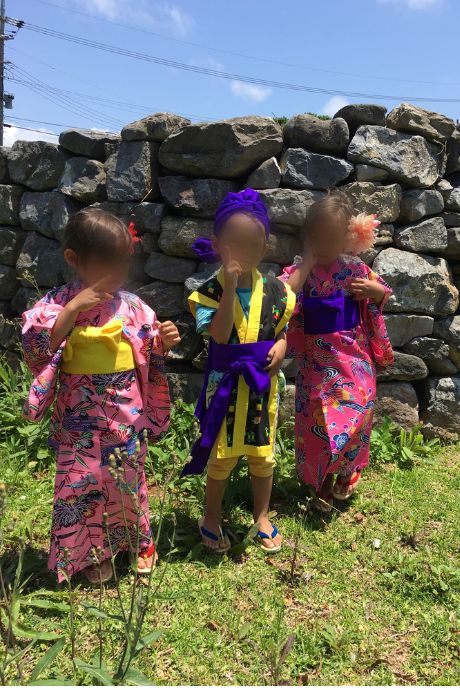
Top 25 Things to Do on Okinawa
From my experience, here are 25 top things to do in Okinawa. Across the 25, I’ve tried to provide a range of different types of experiences and attractions. However, be aware that a must do in Okinawa list could be almost endless.
The list is not ranked based on my most popular to least popular things to do. Instead, I’ve tried to make logical groupings of activities, attractions and experiences.
Below is a map showing the specific locations of each recommended activity. You can click on each item on the map to see the details, and you will stay on this page.
Note that Okinawa Honto, the main island of Okinawa, is 107km / 67 mi long, and can take approximately 2 hours to drive from one end to the other. As a result, you should plan your visit to optimise your travelling time.
1. Okinawa Beaches
One of the main attractions in Okinawa is the beaches. For my family and I, visiting the beaches is definitely one of the top free things to do in Okinawa.
The island is bounded by a golden braid of sand and sea, and there are hundreds of beaches waiting to be discovered – some of them almost unpopulated. The beaches are everywhere, so it is hard to say which are the best beaches in Okinawa.
What to do on the beach is always easy to figure out. While it is clear that the beaches are the best places on Okinawa island, which beach to visit is another matter.
Even in the Naha city centre, the sea is accessible on a sandy strip. The beaches fit kids of any age looking for fun things to do in Okinawa.

Swimming season is typically from April to October but can vary from beach to beach. This website has specific information for individual beaches. The same website also has information on when lifeguards staff the beaches.
Box jellyfish season typically runs from May to October. Some beaches have jellyfish nets in place. This web page has lots of safety information, including venomous sea life like jellyfish.
Here is one beach close to Naha to try:
- Name: Naminoue Beach (波の上ビーチ)
- Address: 3 Chome-3-1 Tsuji, Naha, Okinawa 900-0037 (〒900-0037 沖縄県那覇市辻3丁目3−1)
- Opening hours: 08:30 am – 5:00 pm
- Entrance fee: Free, but there are usage fees for showers and coin lockers.
- Website
- Map link
2. Snorkelling and Diving
Diving in Okinawa, especially if you are an experienced diver, is a dream experience. Even close to the Okinawa tourist spots, diving is one of the must-try activities in Okinawa.
There are several diving schools for those without a diving certificate. Check out the options to book a learn to scuba dive course through Klook, including advanced diving courses.
If you are already scuba certified, you can rent equipment and dive in one of the many diving spots around the islands.
If you’re not into diving, there are plenty of snorkelling options in Okinawa. From splashing around the beaches on Ishigaki Island to observing the sea turtles on Tokashiki Island, snorkelling offers an unparalleled opportunity to watch the marine life in Okinawa.
A great option to plan and book your Okinawa diving and/or snorkelling experience is to check out the options available through Klook.
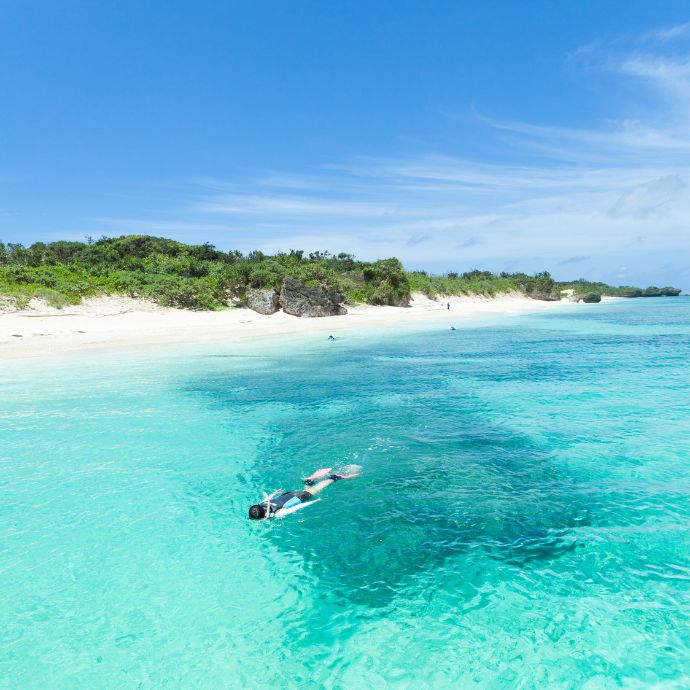
3. Surfing in Okinawa
The swell may be gentler than in Hawaii, but after a typhoon, the waves are world-class challenges for surfers looking for things to do.
Okinawa, Japan, has several surfing hotspots. The breaks are legendary, and there are reefs all around the islands where the swell can be strong after a typhoon, but there are constant waves since the islands face the open South China Sea.
If you plan to surf in Okinawa, travel around the island to find the best swell. The season is from August to March, but since there can be typhoons from April to September, there is a good chance of great waves for a couple of days after the typhoon has passed.
One of the best – and most accessible – surf breaks in Okinawa is the Sunabe Seawall, between Chatan and Kadena. There are several surf breaks of varying difficulty. There is parking close to the beach. Click here to check out the options to book a surfing and SUP experience through Klook.
- Name: Sunabe Beach (砂辺海岸)
- Address: 247-5 Sunabe, 北谷町 中頭郡 沖縄県 904-0111 (〒904-0111 沖縄県中頭郡北谷町砂辺247-5)
- Opening hours: 24 hours (note: No lifeguards in the off-season).
- Map link
4. Kayaking in Okinawa
Imagine gliding along the subtropical coastline, passing glittering beaches and strange rock formations. Kayaking should be on your list of things to do in Okinawa. Japan has no lack of kayaking spots.
If you like water sports, kayaking is one of the best things to do on Okinawa Island and most outlying islands. Okinawa kayaking experiences vary from mangrove kayaking in the rainforest to kayaking in the tropical sea.
Various companies offer the tours, and the location and price are different between all companies.
Click here to check out and book a kayaking experience through Klook.
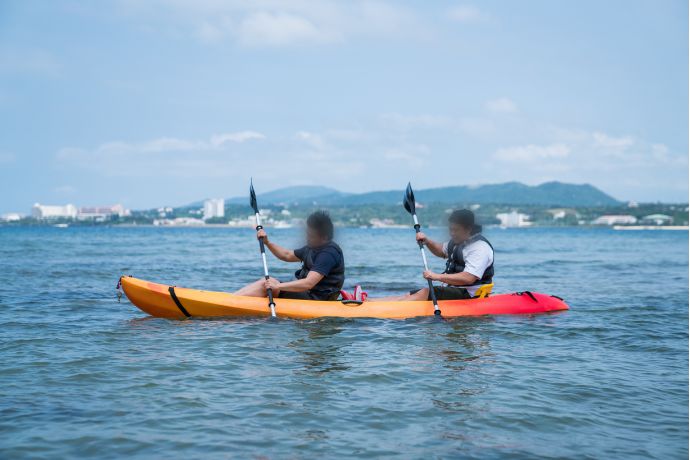
5. Okinawan Food
If you’re working out what to do in Okinawa, you must try the local cuisine. Food in Okinawa makes the most of the fresh seafood and vegetables from the islands. It also demonstrates the many hundred years of Chinese influence on the islands and their culture.
Some facts about the Okinawa diet are that you do not eat until you are full, but 80% full, and the freshness and balance of ingredients are supremely important.
Trying the different dishes in Okinawan cuisine is one of the top 10 things to do in Okinawa. Some of the dishes to try include:
- Champuru – Champuru means to mix together. A common type is Goya Champuru. Goya translates as bitter melon and includes tofu, eggs, pork, soy sauce and salt.
- Rafute – Slow-cooked pork belly braised in soy sauce, sugar, ginger and awamori (an Okinawan distilled liquor).
- Taco rice – A fusion dish influenced by American culture. It’s basically taco ingredients (including seasoned mince) served on rice.
- Okinawan soba noodles.
- Hirayachi – An Okinawan-style savoury pancake made with flour, eggs, and green onions.
- Name: Okinawan cuisine (沖縄料理)
- Website
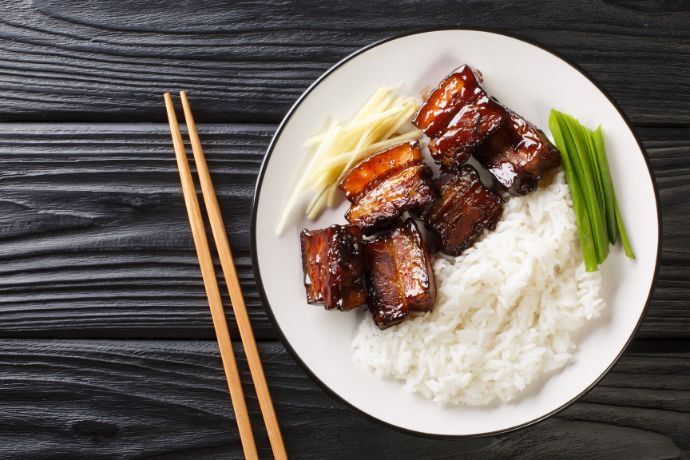
6. Shuri Castle
During the almost 200 years that it was ruled by the Satsuma clan from Japan’s southern island of Kyushu, Okinawa was nominally an independent nation, paying tribute to the Chinese emperor.
Okinawa retained its king until it was formally annexed by Japan in 1879, and the royal residence and official buildings in Shuri castle present a view into a completely different culture from either the Japanese or Chinese.
The castle was designated a UNESCO World Heritage Site in 2000 but sadly burned down almost entirely in 2019.
But even as reconstruction is underway but will last for a few more years (as of this writing in 2023), it is still one of the top things to do in Okinawa.
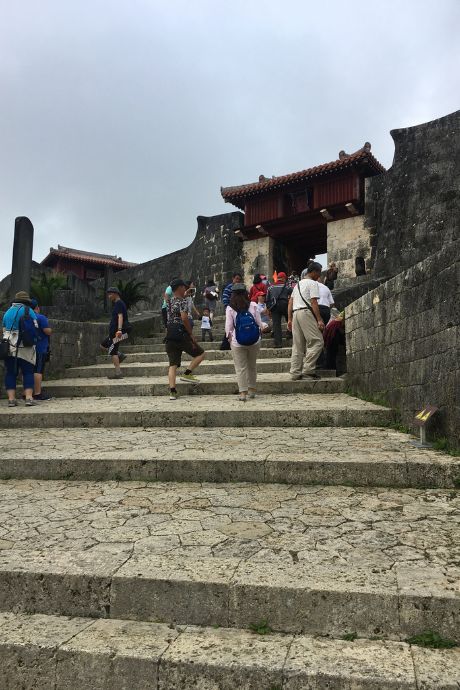
Only parts of it are open to the public, but it is still one of the top Okinawa famous places to visit. This is an Okinawa must-see if you can tear yourself away from the beaches.
- Name: Shuri Castle (首里城)
- Address: 1-2 Shurikinjocho, Naha, Okinawa 903-0815 (〒903-0815 沖縄県那覇市首里金城町1−2)
- Opening hours: Normally 8:00 am – 7:30 pm all days (except New Year). Check on this web page for the most up-to-date information.
- Entrance fee: 400 yen per adult (various discounts apply).
- Website
- Map link
7. Sonohyan Utaki Ishimon
If you are interested in Okinawan culture and religion, Sonohyan Utaki Ishimon (translated as Stone Gate of the Sonohyan Shrine) should be an Okinawa must see. It is located on the grounds of Shuri castle, leading to a sacred grove within.
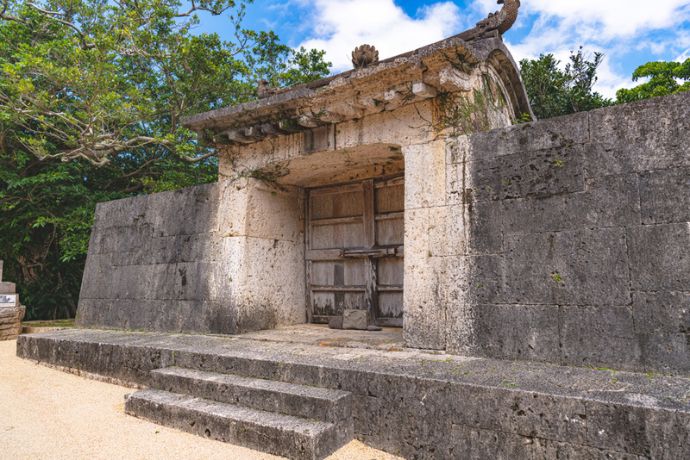
The original religion of Okinawa worships the forces and manifestations of nature, including sacred groves and springs, often located at the old castle sites.
The Okinawan nature worship form differs from the Chinese and Japanese forms. Even if the Okinawans are now Buddhists after several hundred years of Japanese influence, nature worship persists.
- Name: Sonohyan-Utaki Ishimon (園比屋武御嶽石門)
- Address: 1 Chome-17-3 Shurimawashicho, Naha, Okinawa 903-0816 (〒903-0816 沖縄県那覇市首里真和志町1丁目17-3)
- Opening hours: 24 hours
- Entrance fee: N/A
- Website
- Map link
8. Nakijin Castle
Studying the local history is one of the favourite activities in Okinawa among natives and visitors alike.
The islands were ruled by warring clans well into the 16th century; the country was divided into three parts: Around Nakagusuku Castle in the middle of the island, around Shuri Castle and Naha in the southwest, and Nakajin Castle in the north. This is why there are several castles in Okinawa, all of them equally impressive places to visit in Okinawa.
When finally united, the Okinawan kingdom was attacked by Japanese samurai from the Satsuma clan in Kyushu, and the Nakajin Castle was destroyed.
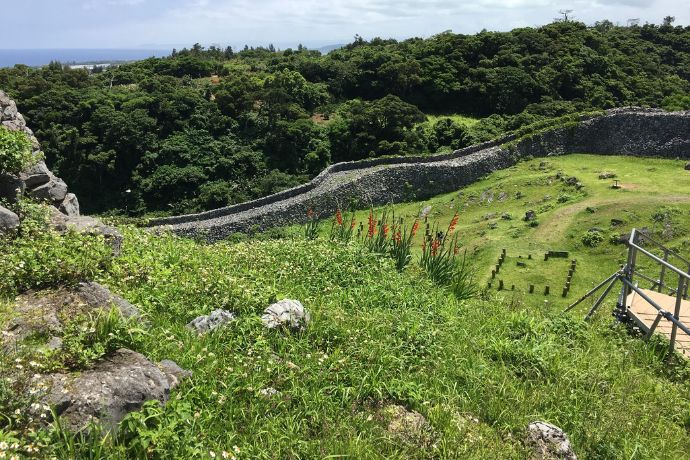
Today, the fortifications remain, impressively rising to improbable heights in the lush landscape. For the student of history, this is one of the best places in Okinawa, and a visit is one of the top things to do in Okinawa.
- Name: Nakijin Castle Ruins (今帰仁城跡)
- Address: 5101 Imadomari, Nakijin, Kunigami District, Okinawa 905-0428 (〒905-0428 沖縄県国頭郡今帰仁村今泊5101)
- Opening hours: 8:00 am – 7:00 pm, with the last entry at 6:30 pm (May to August). Other months: 8:00 am to 6:00 pm, with the last entry at 5:30 pm. More information is on this web page.
- Entrance fee: 600 yen per adult, 450 yen for high school students, and free for elementary students and younger.
- Website
- Map link
9. Shikinaen Royal Garden
Shikinaen Royal Garden is a historic royal garden built in 1799 for the royal family of the Ryukyu royal kingdom.
This is one of the few spots in Okinawa where you cannot see the ocean, and the Okinawan kings brought the Chinese envoys here to demonstrate that their country was no mere island. Today, it is a beautiful garden showcasing Okinawa’s traditional culture.
It combines Japanese and Chinese architectural elements. It is a circuit garden centred around a pond. Nearby, there are two stone markers with inscriptions from Chinese envoys. The pond has a Chinese-style arched bridge, and another bridge leads to the hexagonal Rokkakudo pavilion. On the opposite side of the pond is the Udun Statehouse with its red-tiled roof.
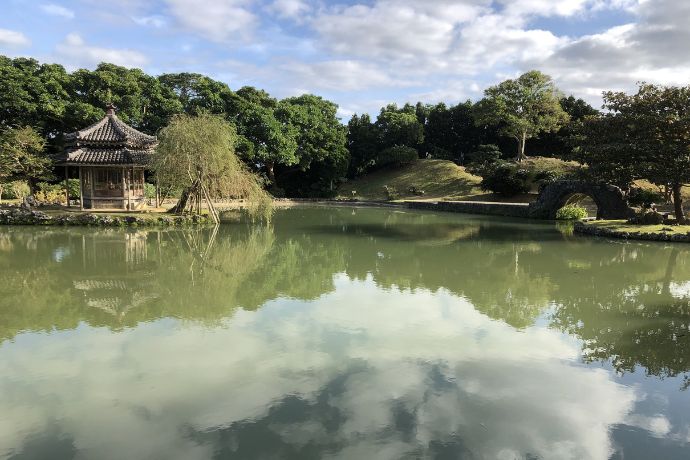
If you’re looking for a botanical garden in Okinawa, the other place to visit is Southeast Botanical Gardens in Okinawa City.
- Name: Shikinaen (識名園)
- Address: 421-7 Maaji, Naha, Okinawa 902-0072 (〒902-0072 沖縄県那覇市真地421-7)
- Opening hours: 9:00 am – 5:30 pm between October 1 and March 30. Rest of the year, 9:00 am – 6 pm (last entrance 5:30 pm).
- Entrance fee: Adults 400 yen, children 200 yen
- Website
- Map link
10. Churaumi Aquarium
The Churaumi Aquarium is one of the most impressive in Japan and the biggest in Okinawa. It is also one of the biggest aquariums in the world.
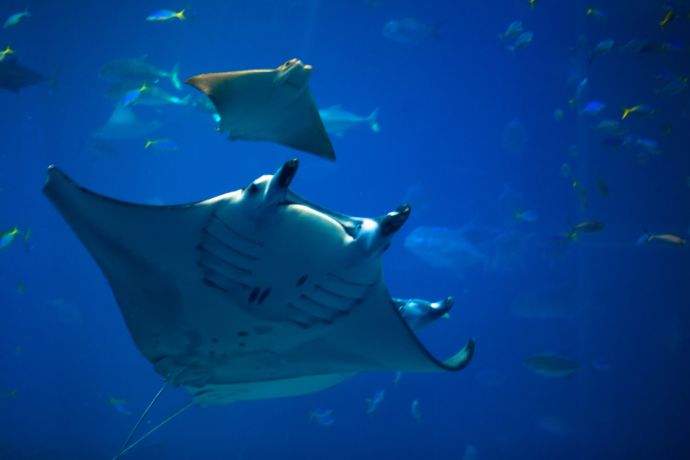
With its enormous tanks reflecting the marine life of Okinawa, it will also show the Okinawa Current, a smaller correspondent to the Gulf Stream, flowing along the Pacific coast of Japan until it finally reaches Miyagi, where it meets the Okhotsk Current flowing south from Hokkaido and the Sea of Okhotsk, creating one of the best fisheries in the world.
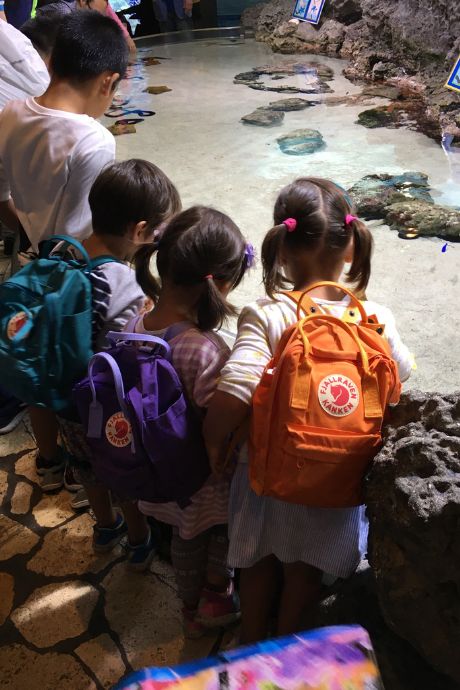
Visiting the aquarium in Okinawa is one of the top 10 things to do in Okinawa.
Click here to check out and book your Churaumi Aquarium Ticket through Klook.
- Name: Okinawa Churaumi Aquarium (沖縄美ら海水族館)
- Address: 424 Ishikawa, Motobu, Kunigami District, Okinawa 905-0206 (〒905-0206 沖縄県国頭郡本部町石川424)
- Opening hours: Opening hours vary depending on the season. Check this web page for up-to-date information.
- Entrance fee: 2180 yen per adult, 1440 yen for high school students, 710 for elementary and junior high students, and children under 6 are free.
- Website
- Map link
11. Ocean Expo Park
A huge park called the Ocean Expo Park surrounds the Churi Aquarium and features a wide variety of attractions. This is one of the best places in Okinawa for a full day of family relaxation.
There is the Oceanic Culture Museum and Planetarium, which is definitely worth a visit. It chronicles the discovery journeys of the South Pacific, kindred in spirit if not flesh to the ancient Okinawans. It has a terrific collection of canoes, ships and anthropological exhibits.
If you’re looking to relax and enjoy playing in the water, Ocean Expo Park is home to Emerald Beach, one of the most beautiful beaches in Okinawa.
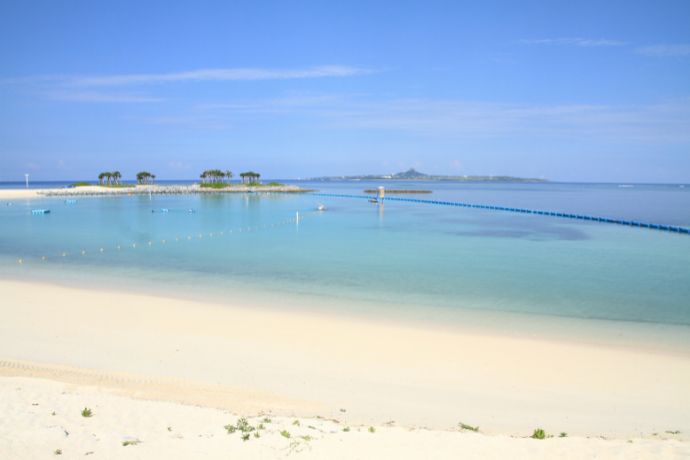
At Ocean Expo Park, you will also find a reproduction of a native Okinawan village and the Omoro Botanical Garden. You can also explore a tropical and subtropical arboretum at Ocean Expo Park, with over 400 species over 17 acres.
The Tropical Dream Centre is definitely worth checking out, with its three greenhouses displaying over 2,000 orchids. In the greenhouses, there are also other tropical and sub-tropical flowers as well as tropical fruit plants. There is also a 36-metre (188 feet) tall tower from which you can enjoy a view over the park.
Plenty of kid’s playgrounds, restaurants and cafes, as well as shops, are scattered throughout the park.
On this handy Ocean Expo Park Guide Map, you can find out more about what the park has to ffer.
- Name: Ocean Expo Park Management (海洋博公園)
- Address: 424 Ishikawa, Motobu-cho, Motobu, Kunigami District, Okinawa 905-0206 (〒905-0206 沖縄県国頭郡本部町石川424)
- Opening hours: 08 am – 6 pm
- Entrance fee: Park entrance is free, but the Tropical Dream Center costs 760 yen per adult with children free, and the Oceanic Culture Museum is 190 yen per adult with children also free.
- Website
- Map link
12. Blue Cave Okinawa and Cape Maeda
The caves of Okinawa can be found across the islands, many with tragic histories from the American invasion, but the Blue Cave in Okinawa does not share that.
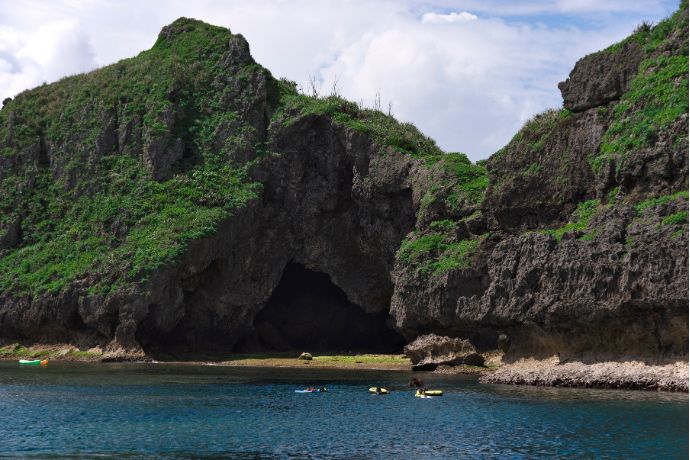
It is one of the top Okinawa famous places to visit if you are a diver. Diving and snorkelling in the Blue Cave in Okinawa are strictly regulated, and the beach management company sets rules to minimise danger.
The corals start very close to the shore, making them easy to observe while snorkelling.
Even if you are not a diver, the spectacular rock formations at Cape Maeda should be on your must see in Okinawa list.
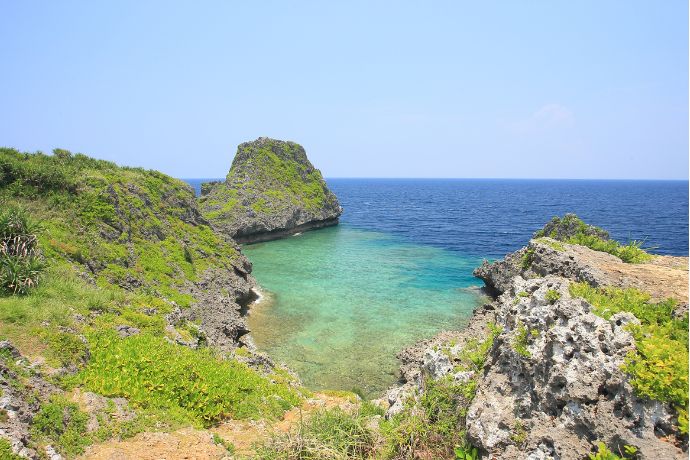
Cape Maeda and the Blue Cave are some of the most popular destinations in Okinawa, so parking can be very crowded.
Click here to check out and book your Blue Cave Diving or Snorkelling experience through Klook.
- Name: Cape Maeda (真栄田岬)
- Address: 469-1 Maeda, Onna, Kunigami District, Okinawa 904-0417 (〒904-0417 沖縄県国頭郡恩納村真栄田469-1)
- Opening hours: 7:00 am – 5:30 pm (parking); visitors centre open from 8:30 am – 9:0 pm
- Entrance fee: Parking is 100 yen per hour, showers are 200 yen and coin lockers are 100 yen.
- Website
- Map link
13. Cape Manzamo
The Okinawa rocks are soft, which is why there are so many caves in Okinawa – and why limestone rock formations such as the “elephants trunk” at Cape Manzamo can form.
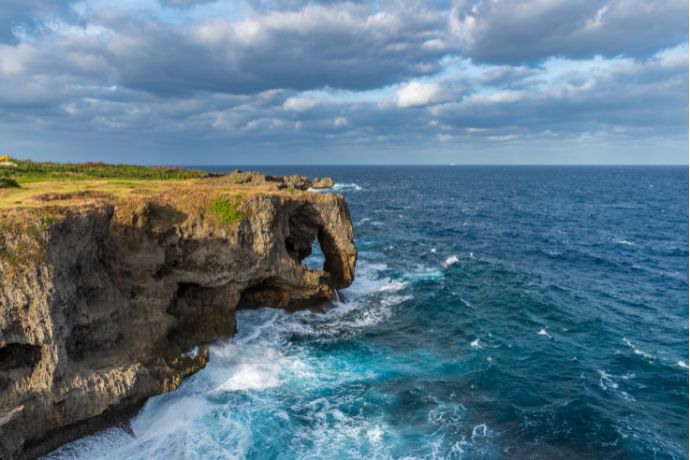
In addition to its most distinguishing feature, the elephant trunk rock formation, a beautiful grassed plateau leads to the rock formation. Cape Manzamo also has fantastic views over the East China Sea and is an excellent spot for sunsets.
- Name: Cape Manzamo (万座毛)
- Address: Onna, Kunigami District, Okinawa 904-0411 (〒904-0411 沖縄県国頭郡恩納村恩納)
- Opening hours: 8:00 am – 7:00 pm
- Entrance fee: 100 yen per person (in the vending machine in the visitor’s centre).
- Website
- Map link
14. Yambaru National Park
If you have only been to the urbanised and cultivated southern Okinawa, Yambura National Park in northern Okinawa may be a ‘nature shock’. As a note, you might see its name spelled as either “Yambaru” or “Yanbaru”.
It houses species of both animals and plants that aren’t found anywhere else. One example of an endemic species is the Okinawa Rail (a species of bird).
Yambaru also offers stunning landscapes, including subtropical forests, waterfalls, cliffs and the highest mountain on the main island. It also offers many outdoor activities and is culturally significant to the indigenous Ryukyuan people.

A visit to Yambaru is a relaxing counterpoint to Japan’s urban and commercialised tourist spots.
- Name: Yambaru National Park (やんばる国立公園)
- Address: Hentona, Kunigami, Kunigami District, Okinawa 905-1411 (〒905-1411 沖縄県国頭郡国頭村辺土名)
- Opening hours: The park is open 24 hours. Okinawa Rail Ecology Center 9:00 am – 5:00 pm; Yambaru Wildlife Conservation Center 10:00 am – 4:30 pm.
- Entrance fee: Okinawa Rail Ecology Center: 500 yen for adults and 200 yen for children.
- Website
- Map link
15. Okinawa Waterfalls
Okinawa’s waterfalls might seem relatively modest compared to falls in other parts of Japan and around the world. While Okinawa’s waterfalls might not be the main attractions in the prefecture, they offer a blend of nature, culture, and adventure that can definitely make visiting them worthwhile.
When the water flow is strong, seeing the waterfalls is one of the best things to do in Okinawa. One factor that makes them worth visiting is their setting in lush tropical rainforests. The trek to get them can be as worthwhile as seeing the falls.
One of the more accessible falls, if you are driving, is Todoroki Waterfall, which is smaller but surrounded by a pleasant and well-kept park (although there is an entry fee). A number of falls (such as Todoroki Falls) are very accessible. Other waterfalls in Okinawa can be more of an adventurous journey.
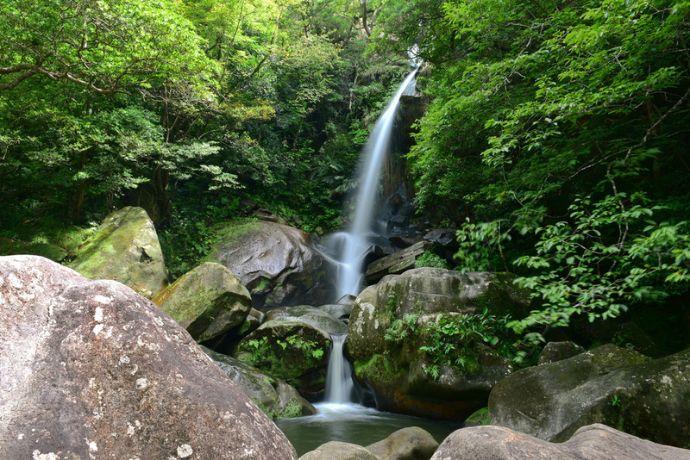
They also vary significantly in size and appearance. For example, Pinaisara Falls is 55 metres (180 feet) tall, while the Kura Falls are smaller and picturesque. Many waterfalls on Okinawa are also less crowded, particularly if they are a little off the beaten path.
A number of falls are located on the main island of Okinawa, mostly in the main island’s northern part. If you go to the Yambaru National Park, several waterfalls near the hiking paths are accessible for free.
- Name: Todoroki Falls (轟の滝)
- Address: 594 Sukuta, Nago, Okinawa 905-0023 (〒905-0023 沖縄県名護市数久田594)
- Opening hours: 09 am – 6 pm
- Entrance fee: 200 yen for adults and 100 yen for children and seniors.
- Website
- Map link
16. Nago Pineapple Park/Pineapple Park Okinawa
Well into the 20th century, pineapple cultivation was a significant industry in Okinawa. However, just like in Hawaii, the industry was outcompeted by cheaper labour in the Philippines.
These days, the Okinawa tourist spots built around the former pineapple industry are some of the more popular activities of things to do in Okinawa Japan.
But the Nago Pineapple Park exists to remind visitors of the era – although true to Japanese form, it has become a cake bakery and souvenir store. And they keep adding to the attractions – the latest is a distillery for pineapple brandy and the previously existing pineapple winery.
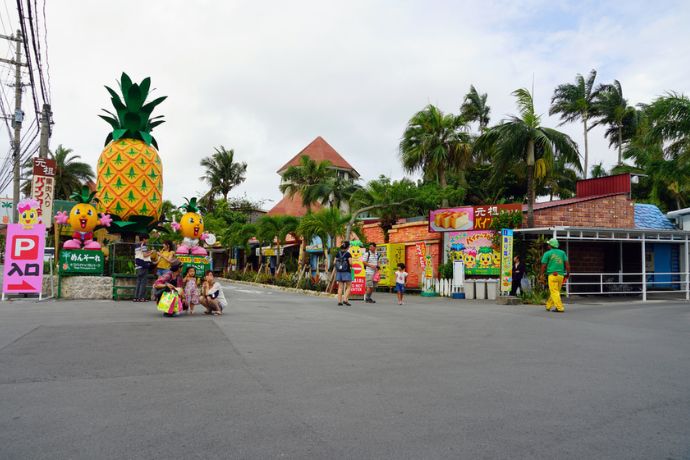
It will be on the itinerary of any tour company, but there are good reasons you should include it in your Okinawa sightseeing.
Click here to check out and book your Nago Pineapple Park Ticket through Klook.
- Name: Nago Pineapple Park (ナゴパイナップルパーク)
- Address: 1195 Biimata, Nago, Okinawa 905-0005 (〒905-0005 沖縄県名護市為又1195)
- Opening hours: March – September 10 am – 6 pm, off-season closed weekdays. Check the website for opening hours.
- Entrance fee: Adults 1200 yen, children 600 yen. Free for children under four years of age.
- Website
- Map link
17. Okinawa World
Okinawa World is a theme park showcasing Okinawan culture. It consists of attractions including Gyokusendo Cave, a tropical fruit garden, and a reconstruction of a Ryuku Kingdom village you can walk around.
In addition, there are demonstrations of traditional crafts (many of which offer hands-on experiences) as well as Okinawan music and dance performances.
Finally, a small zoo focuses on the Habu snake and a small range of other animals. There is also a snake show, which occurs three times a day. You’ll also have plenty of opportunities to purchase souvenirs at Okinawa World.
The best thing to do at Okinawa World is Gyokusendo Cave. At five kilometres (3.1 miles), it’s the longest cave in Okinawa and the second biggest in Japan. 850 metres (0.5 miles) of the cave is open to the public. It’s pretty spectacular, and on a hot day, visiting the cave underneath the complex is one of the best things to do in Okinawa to cool down.
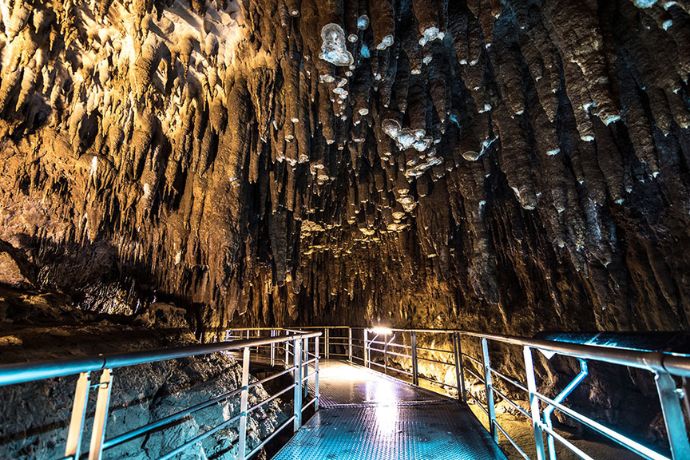
The traditional craft workshops and demonstrations are engaging, but you pay extra for the various craft experiences. The cost of these can quickly add up. The music and dance performances are also quite entertaining.
From an animal welfare point of view, I would give the zoo section and snake show a miss.
Click here to check out and book your Okinawa World Ticket through Klook.
- Name: Okinawa World (おきなわワールド)
- Address: Maekawa-1336 Tamagusuku, Nanjo, Okinawa 901-0616 (〒901-0616 沖縄県南城市玉城前川1336)
- Opening hours: 9:00 am – 5:30 pm, with the last admission at 4:00 pm. See this page for more information.
- Entrance fee: 2000 yen for adults and 1000 yen for children.
- Website
- Map link
18. Ryukyu Mura
Okinawan culture is very different from the culture of the Japanese mainland.
This is no more evident than in the Ryukyu Mura, a small theme park created to showcase traditional Okinawan arts and crafts, including architecture and festivals.
You can watch shows and crafts here, eat a traditional meal, and visit the huge souvenir shop.
Click here to check out and book your Ryukyu Mura Ticket through Klook.
- Name: Ryukyu Mura (琉球村)
- Address: 1130 Yamada, Onna, Kunigami District, Okinawa 904-0416
- Opening hours: 09 am – 5:30 pm
- Entrance fee: Adults 1500 yen, plus separate fees for various activities.
- Website
- Map link
19. American Village Okinawa
If your idea of Okinawa attractions includes a Ferris wheel on top of a shopping centre, this is the place for you. One of the best shopping places in Okinawa, the American Village Okinawa in Chatan (also known as Mihama American Village) is an America-themed shopping mall.

Like so many other places with an American theme in Japan, it tends to be more Japanese than American, but it collects a lot of stores in one place.
- Name: American Village (美浜タウンリゾート・アメリカンビレッジ)
- Address: Mihama, Chatan, Nakagami District, Okinawa 904-0115 (〒904-0115 沖縄県中頭郡北谷町美浜)
- Opening hours: 10:00 am – 10:00 pm
- Entrance fee: Free
- Website
- Map link
20. Kokusai Dori (Street)
Naha, the capital of Okinawa, is a bustling city, and Kokusai Dori is one of the top things to do in Naha, Okinawa.
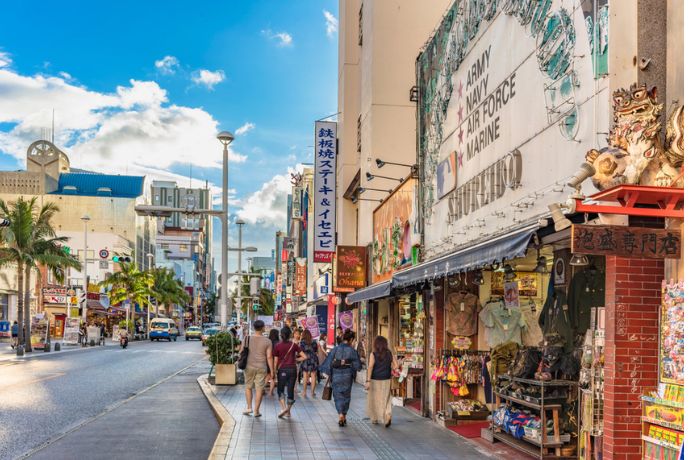
Among the fun things to do in Okinawa, this is high on the list, particularly if you are into bar-hopping and late-night partying. It’s many people’s favourite answer to what to do in Okinawa at night.
If you plan to experience the nightlife in Okinawa, Kokusai Dori is a great place to start. And it is also great if you want to go shopping in Okinawa during the daytime.
21. Kouri Island
This small island is located off the northern part of the main Okinawa island. It is connected to the main island by a bridge that is almost two kilometres (1.25 miles) long.
Kouri Bridge (completed in 2005) is one of the longest toll-free bridges in Japan. However, it’s significantly shorter than Irabu Ohashi Bridge (completed in 2015) which is also in Okinawa and is 3.5 kilometres (2.2 miles) long.
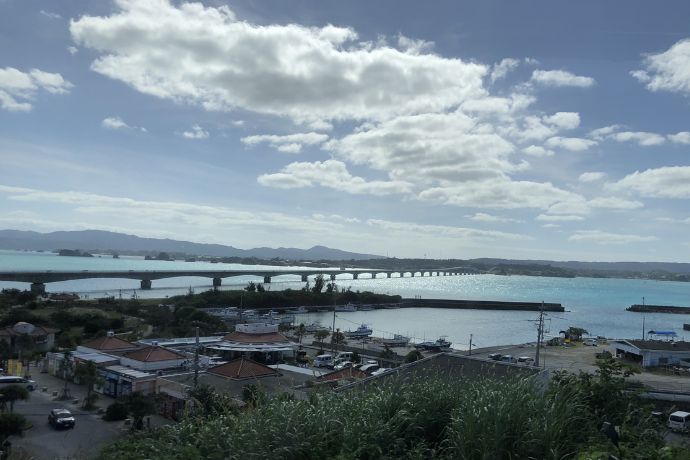
Like many other parts of Okinawa, there are some beautiful beaches, such as Kouri Beach. The island is also known for two heart-shaped rock formations at Tinu Hama Beach on the island’s northern side.
The main facilities on the island are centred on the Kouri Ocean Tower. This observation tower offers stunning views of the sea and the northern Okinawa shoreline from the top.
- Name: Kouri Island (古宇利島)
- Address: 538 Kouri, Nakijin, Kunigami District, Okinawa 905-0406 (〒905-0406 沖縄県国頭郡今帰仁村古宇利538)
- Website
- Map link
22. Ishigaki Island
The main island in the Yaeyama group of islands, Ishigaki, is the portal to Japan’s southernmost and westernmost corners.
Sitting a two-hour flight from Naha and so close to Taiwan that you can see the island without binoculars on a clear day, the culture of Ishigaki is slightly different from the main Okinawan culture. And so is the cuisine.
One of the local delicacies is goat soup. Another well-known dish is Yaeyama Soba noodles. Ishigaki Island is also famous for Ishigaki-gyu, the beef from cattle raised on the island. Apart from the serene, natural environment they are raised in, part of their diet consists of sugar cane by-products (grown on the island).
Ishigaki Island has many spectacular beaches, including a mix of both rocky and sandy beaches. It’s also known for its diverse marine life surrounding the island.
Click here to check out things to do on Ishigaki Island through Klook.
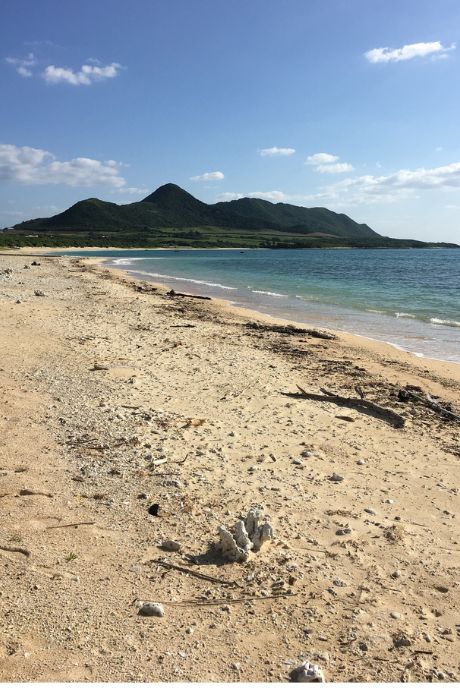
Some of the most known and beautiful natural attractions include Kabira Bay and Iriomote-Ishigaki National Park (the following two things are also separately on my list of the top 25 things to do in Okinawa). They warrant their own place!
23. Kabira Bay
Visiting Kabira Bay should be at the top of your list of things to do if you have the time to visit Ishigaki Island. Kabira Bay is a paradise for marine life enthusiasts, including beautiful coral formations.
It’s an excellent spot for relaxation and photography (because of its picturesque setting and striking colours). Kabira Bay is also known for the cultivation of black pearls, and you can purchase black pearl jewellery as souvenirs.
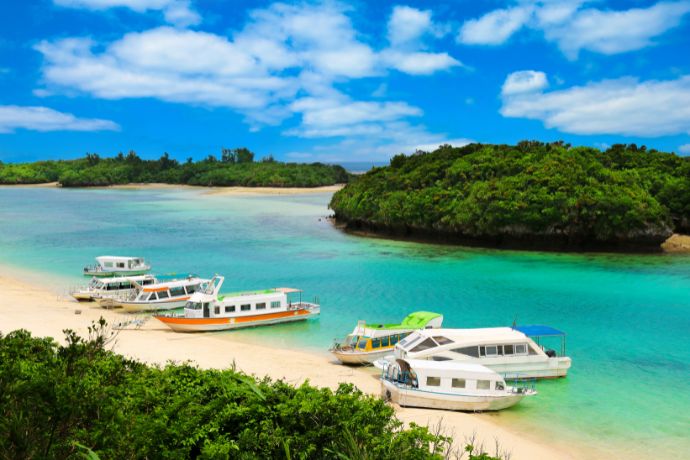
You cannot dive because of the treacherous currents. Still, glass-bottomed boats take tourists out on the bay, providing as good or an even better view than you would get if you snorkelled yourself. The boats depart from the shore, so you must go there and make arrangements yourself.

- Name: Kabira Bay (川平湾)
- Address: 〒907-0453 Okinawa, Ishigaki, Kabira, 川平公園 (〒907-0453 沖縄県石垣市川平 川平公園)
- Map link
24. Iriomote Ishigaki National Park
Large parts of Ishigaki Island and the nearby Irimote islands form the Ishigaki-Irimote National Park. The park’s main purpose is to protect the sea and marine life between the islands.
The national park is one of the top attractions in Okinawa for anyone who wants to experience slow life in a beautiful setting. It’s home to a diverse range of ecosystems, with a number of species endemic to the area, including the endangered Iriomote wildcat. It has some stunning landscapes, including secluded beaches and great trekking options.
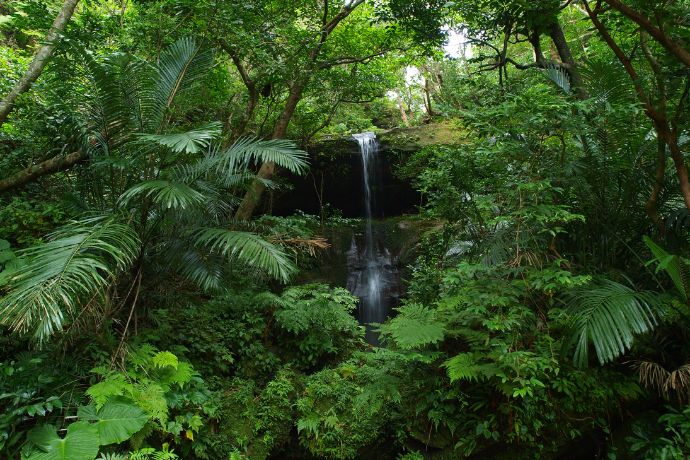
It is also designated an International Dark Sky Park (ISDP). It is one of the few places to visit in Okinawa and Japan where you can observe the stars completely without any light pollution, enabling you to appreciate the night sky.
- Name: Iriomote Ishigaki National Park (西表石垣国立公園)
- Address: Komi, Taketomi, Yaeyama District, Okinawa 907-1432 (〒907-1432 沖縄県八重山郡竹富町古見)
- Opening hours: The park is open 24 hours. Taketomi-jima Visitor Center 8:00 am to 5:00 pm.
- Entrance fee: N/A
- Website
- Map link
25. Miyakojima
About two hours’ flight from the main Okinawan island, the small island of Miyakojima is even more of a beach-lovers paradise. Many visitors would top the list of the best islands in Okinawa with Miyakojima.
The island is sometimes known as Miyakojima Island but ‘jima’ means ‘island’ in Japanese. So, it’s more accurate to refer to it as either Miyako Island or Miyakojima.
For beach lovers, this is one of the top attractions in Okinawa, including the longest beach in Japan, an underwater observation centre, and snorkelling and diving opportunities in the shallow seas. There are more diving schools than ordinary schools in Miyakojima.
Click here to check out things to do on Miyakojima Island through Klook.

The main island connects several smaller islands through bridges and causeways, making even more beaches available.
- Name: Miyako-Jima (宮古島)
- Address: Nishizato-1140番地 Hirara, Miyakojima, Okinawa 906-0012 (〒906-0012 沖縄県宮古島市平良西里1140番地)
- Website
- Map link
Best Time to Visit Okinawa
Everyone has their own idea about the best time to take a holiday. What you enjoy—sunny weather, unique activities, quiet places, or affordable trips—shapes your choice.
That said, if you’re after pleasant weather, fewer crowds, and good deals, March and April are excellent, but avoid the busy ‘Golden Week’ at the end of April. October to November is also fantastic. Mid-February onwards, as well as December, are also good options.
Other months of the year can still be great times to visit Okinawa, but you should expect more weather and tourist issues.
Let’s take a closer look at the weather and tourist volumes.
Weather
First, let’s have a quick look at the weather by each season. You’ll notice that Spring and Autumn will be the most pleasant overall in terms of the weather.
Winter (December to February)
Winter in Okinawa is mild due to its sub-tropical location. Average max temperatures are around 20°C and get down to about 15°C overnight. Lighter clothes should be okay for most people, but you may want to wear longer pants and you might need a jacket in the evenings.
Rainfall in Winter is also generally lower than in other months. The combination of mild temperatures and clear skies is great for sightseeing and experiencing Okinawan culture. Cherry blossom season in Okinawa is normally in mid-January to early February as well.
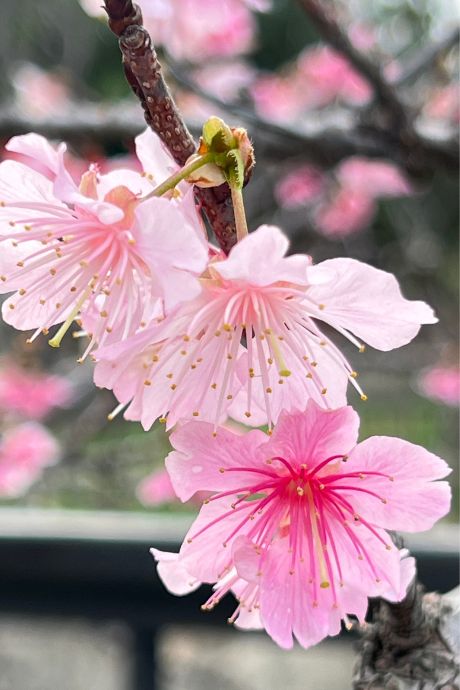
The bigger issue with visiting Okinawa at this time of year from a weather point of view is that the sea temperature will be cooler, which is not great for swimming at the beach or doing other water-based activities. Also, this time of year is outside the official swimming season, which is April to October for most beaches, so don’t expect lifeguards or jellyfish nets.
Spring (March to May)
The temperature in Okinawa in Spring warms from daily max temperatures of 22 to 23°C in March to around 27 to 28°C in May. Rainfall is still relatively low until the rainy season begins later in May.
The weather in Spring is pleasant for sightseeing. Many flowers will also be blooming (but not cherry blossoms). Water temperature will also be increasing, making swimming and other water-based activities more pleasant. The official swimming season also starts at different times in April (depending on the beach).
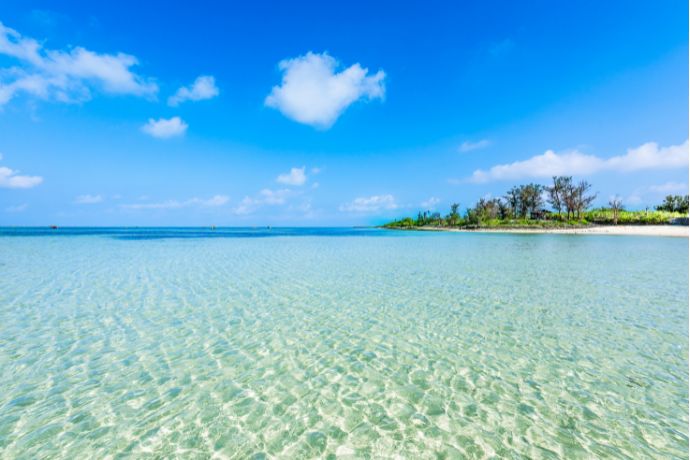
Once the rainy season starts, there will be more cloudy and overcast days. The rainy season is part of late Spring and early Summer. May and June are the months with the most rainfall. It’s common to have sudden showers, which are quite heavy, but it’s unusual for rain all day.
Summer (June to August)
Summer in Okinawa is hotter and more humid. The average max temperature over Summer ranges between 30 and 32°C. The average humidity is between 80 and 90% and is highest in June.
June is generally the wettest month of the year. Also, the regular typhoon season is between June and September. However, typhoons have become more unpredictable in recent years, and occasional typhoons can occur as early as April and into November. Always check for typhoon forecasts and advisories if planning a trip during typhoon-prone months.
The high humidity can be uncomfortable, and the heavy rains or typhoons will be disruptive if they occur. The benefit of this time of year is that the higher sea temperatures are perfect for water activities, and the landscapes will be vibrant and lush.
Autumn/Fall (September to November)
The max temperatures gradually fall throughout Autumn from around 30 to 31°C in September to 24/25°C in November. September is consistently one of the wettest months in the year and is also still part of the primary typhoon season. Rainfall reduces in October and November, and the risk of typhoons decreases.
October and November are pleasant times to visit as the temperature is comfortable, there is reduced rain, and the water temperatures are still quite pleasant. The swimming season continues into October at Okinawan beaches (with the closing dates varying between beaches). You can also look forward to Fall foliage later in Autumn.
Tourist Volumes
The volume of tourists visiting a place is very important when working out the best time to visit any destination, and Okinawa is no different. The primary groups visiting Okinawa are domestic Japanese tourists as well as Chinese Tourists.
Domestic Japanese Tourists
Higher tourist volumes largely follow the vacation periods in the Japanese calendar. The island’s tourist facilities become very crowded during these periods.
At the time of writing, the current weak yen means foreign visits are out of reach for many Japanese, meaning domestic tourism to places like Okinawa increases. This will likely reverse when the yen becomes stronger.
The Japanese summer vacations during July and August, in particular, are usually very busy. Japanese vacation periods you must consider are the following:
- New Year in early January,
- Golden Week from 29 April to 5 May,
- Obon in August, and
- Silver Week in mid-September (Silver Week does not occur every year).
Chinese Tourists
Okinawa is also a popular destination for Chinese tourists, with the flight from Naha to Shanghai being shorter than from Naha to Tokyo.
During the big Chinese holidays, mainly the Spring Festival (Chinese New Year) at the end of January to the beginning of February, and Chinese Golden Week in the first week of October, the influx of tourists saturates all available accommodation and transportation.
Summary of the Best Time to Visit Okinawa
Once you combine the weather with tourist volumes, the best times to visit are March, April, October, and November. They provide the best combination of pleasant weather, a lower number of tourists, and more affordable vacations.
Mid to late February and December are also great times to visit but aren’t as good for water-based activities. You can expect a great time if you visit Okinawa at other times of the year but there may be weather and crowd-related issues.
How to Get to Okinawa
There are two ways to get to Okinawa and around the islands: flying and ferry.
Flying
Flying is the most common option, and there are plenty of flights with both the flag carriers of JAL and ANA from the major airports and with low-cost carriers like Peach and Jetstar Japan, both from Narita and Haneda for Tokyo, Kansai International Airport (KIX) for Osaka, and from smaller airports near the big cities, like Kobe for Osaka.
And once you land, there are hundreds of things to do on Okinawa island, not to speak of the rest of the archipelago. Working out which are the best islands in Okinawa to visit is not easy to answer in a prefecture with hundreds of islands. Still, it is hard to go wrong if you start with the main Okinawa island.
Ferry
Another option for getting to Okinawa is to go by ferry. Air freight to Okinawa is expensive, which means there are ferries from the big ports on the south coast of Japan to Okinawa. Some of the ferry lines offer luxury options, making the overnight trip a mini-cruise. The ferries from the mainland all go to Naha.
Ferries to outlying islands start at other ports of Okinawa. If you want to take the ferry to visit other cities of Okinawa – which in reality means the different archipelagos – you may have to find different ports.
The below map shows both the flight and ferry route options.
How to Get Around Okinawa
When you visit Okinawa, your means of transportation depends on what you want to see and do.
Getting Around Naha
In the Naha city centre, parking is as scarce and expensive as in any Japanese city, so if you plan to visit Naha, it is better to do it after you drop off your car and use taxis and public transport.
If you are staying in Naha city, taking a taxi and taking the monorail, which serves most parts of the city, works well. There are also local buses, but those peter out as you get some distance from the city centre.
Getting Around the Rest of Okinawa
There are a number of options for getting around the rest of Okinawa, but for many people renting a car will be the most flexible and best option. Check out the option to rent a car through Klook.
Private Tour or Group Bus Tour
If you want to quickly tick off some of the major sights and do not care about exploring. In that case, you might be better off taking a private or bus tour. Klook offers a great selection of Okinawa tours. Click here to check out and book your tour through Klook.
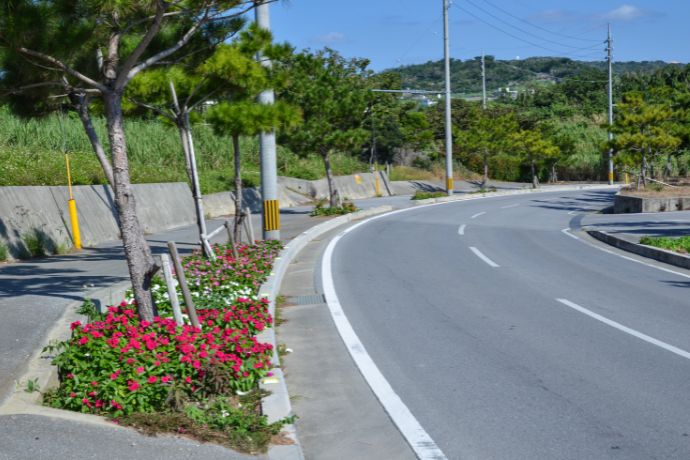
Renting a Car
However, if your vision of “What To Do In Okinawa” means exploring independently, getting around means renting a car. But of course, you need to know what you want to see. Check out the option to rent a car through Klook.
The things to do Okinawa has to provide are spread out all over the islands. The Okinawa prefecture has three groups of islands: Okinawa’s main islands and the near archipelago, Miyakojima, and the Yaeyama islands furthest to the south. For example, visiting the best beaches in Okinawa means driving yourself.
For drivers, it is easy to figure out what to do in Okinawa Japan as there are a common set of rules for drivers, which I write about in my Driving in Japan article. Driving in Okinawa is easier than other parts of Japan. The driving is less busy and more relaxed, the speed limits are lower, and since no trains exist in Okinawa: you do not have to remember to stop, look, and listen at railway crossings.
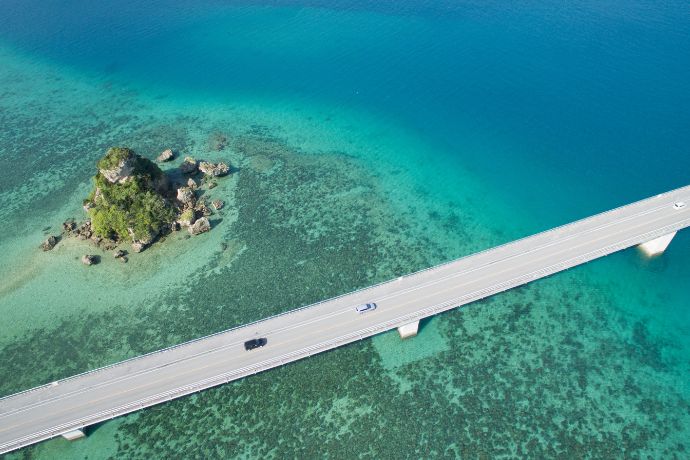
If you rent a car, attractions provide free and ample parking. Some have enormous parking lots (the Ocean Expo park in Motobu has several parking lots with hundreds of spaces in each), so if you park there, remember where you parked your car and do not lose it.
Other Transport Options
There are alternatives to the car, but they’re not great for most people. For example:
- The Okinawa Hop on Hop Off Bus option has two courses to choose from. Click here to check out and book your ticket through Klook.
- There are highway buses, but they’re infrequent.
- Taking a taxi is not an option either, as Okinawa is so long that it takes 2.5 hours to drive on the highway from the southern to the northern tip of the island.
- If you are fit, you could rent a bicycle and ride around the island, which means navigating off the highway.
Final Thoughts and Tips
The fun things to do in Okinawa are almost infinite. It will be harder to narrow down your Okinawa what to do list in the limited time you will probably have rather than to find things to do. So you need to plan and select carefully.
Planning your Okinawa visit, both what to do and when to go, is the key to the success of your visit. But it is hard to go wrong when looking for interesting things to do in Okinawa, whatever you choose.
Frequently Asked Questions – Things to Do in Okinawa
Okinawa is a destination in itself. It is one of the most accessible destinations in Japan – both physically and when it comes to the attitude of the locals. It is hard to get your Okinawa visit wrong.
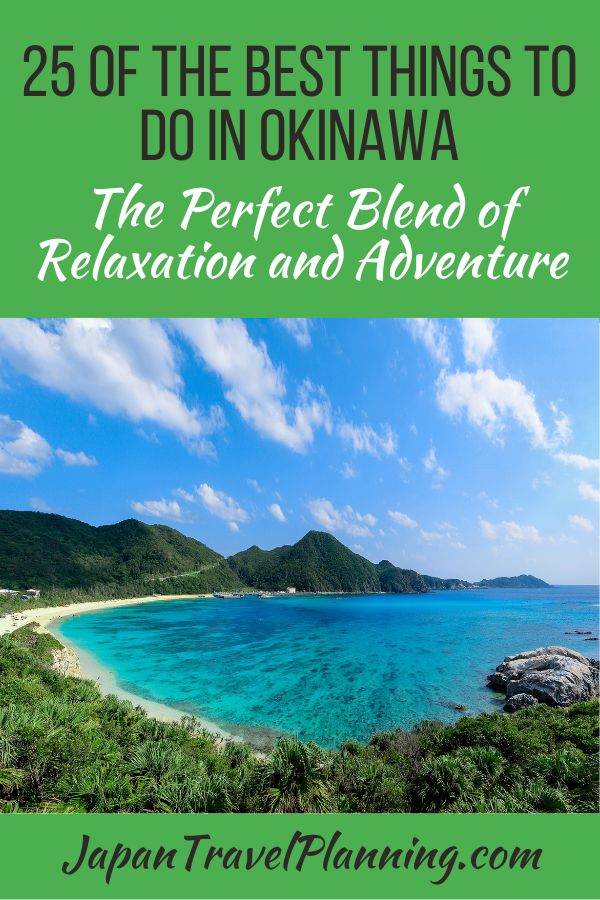
Join the Japan Travel Planning Facebook Group or Discord Server
You are also welcome to join our Japan Travel Planning Facebook Group and our Japan Travel Planning Discord Server – they are great resources to enable you to ask questions about your upcoming trip to Japan!
Disclaimer: This article contains affiliate links. If you book after clicking on one of these links then we may receive a small commission at no extra cost to you.


